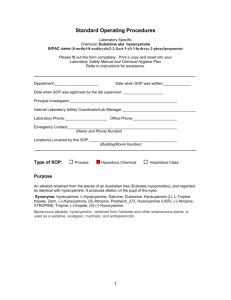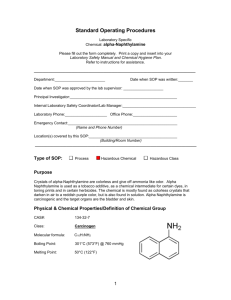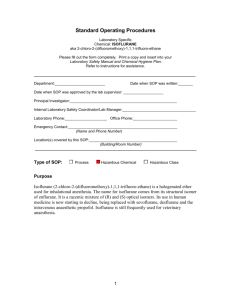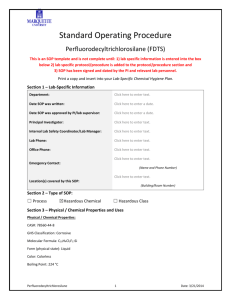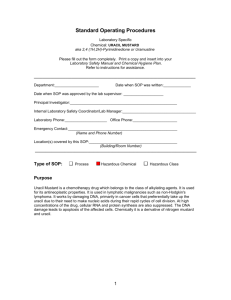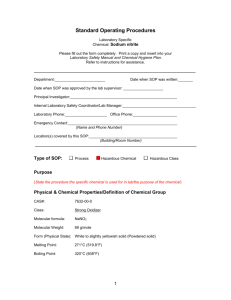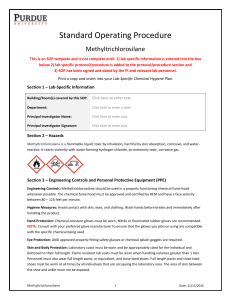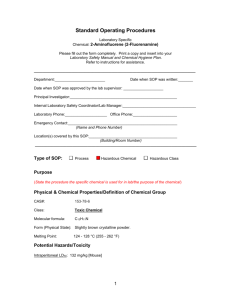UCLA - Environmental Health & Safety
advertisement
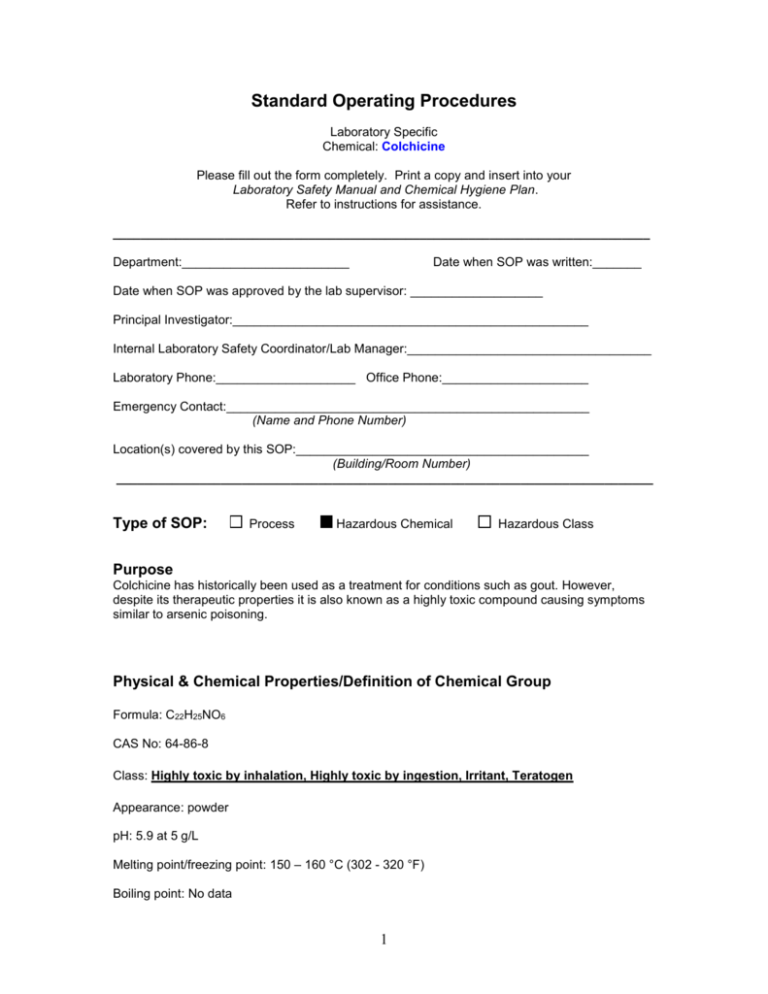
Standard Operating Procedures Laboratory Specific Chemical: Colchicine Please fill out the form completely. Print a copy and insert into your Laboratory Safety Manual and Chemical Hygiene Plan. Refer to instructions for assistance. _____________________________________________________________________________ Department:________________________ Date when SOP was written:_______ Date when SOP was approved by the lab supervisor: ___________________ Principal Investigator:___________________________________________________ Internal Laboratory Safety Coordinator/Lab Manager:___________________________________ Laboratory Phone:____________________ Office Phone:_____________________ Emergency Contact:____________________________________________________ (Name and Phone Number) Location(s) covered by this SOP:__________________________________________ (Building/Room Number) _____________________________________________________________________________ Type of SOP: Process Hazardous Chemical Hazardous Class Purpose Colchicine has historically been used as a treatment for conditions such as gout. However, despite its therapeutic properties it is also known as a highly toxic compound causing symptoms similar to arsenic poisoning. Physical & Chemical Properties/Definition of Chemical Group Formula: C22H25NO6 CAS No: 64-86-8 Class: Highly toxic by inhalation, Highly toxic by ingestion, Irritant, Teratogen Appearance: powder pH: 5.9 at 5 g/L Melting point/freezing point: 150 – 160 °C (302 - 320 °F) Boiling point: No data 1 Flash point: No data Ignition temperature: No data Autoignition temperature: No data Lower explosion limit: No data Upper explosion limit: No data Vapor pressure: No data Water solubility: Soluble Potential Hazards/Toxicity Swallowed: Severely toxic effects may result from the accidental ingestion of the material; animal experiments indicate that ingestion of less than 5 gram may be fatal or may produce serious damage to the health of the individual. Eye: There is evidence that material may produce eye irritation in some persons and produce eye damage 24 hours or more after exposure. Severe inflammation may be expected with pain. Skin: The material is not thought to be a skin irritant (as classified using animal models), abrasive damage however, may result from prolonged exposures. Skin contact with the material may damage the health of the individual; systemic effects may result following absorption. Open cuts, abraded or irritated skin should not be exposed to this material. Entry into the blood-stream, through, cuts, abrasions or lesions, may produce systemic injury with harmful effects. Examine the skin prior to the use of the material and ensure that any external damage is suitably protected. Inhaled: Inhalation of dusts, generated by the material, during the course of normal handling, may produce severely toxic effects; these may be fatal. The material is not thought to produce respiratory irritation (as classified using animal models). Nevertheless inhalation of dusts, or fume, especially for prolonged periods, may produce respiratory discomfort and occasionally, distress. Persons with impaired respiratory function, airway diseases and conditions such as emphysema or chronic bronchitis, may incur further disability if excessive concentrations of particulate are inhaled Chronic health effects: Ample evidence exists, from results in experimentation, that developmental disorders are directly caused by human exposure to the material. Long term exposure to high dust concentrations may cause changes in lung function i.e. pneumoconiosis; caused by particles less than 0.5 micron penetrating and remaining in the lung. Colchicine is readily absorbed from the gastro-intestinal tract. Steatorrhoea (fatty stools) and a histiocytic lymphoma in the jejunum (part of small intestine) developed in a 53 year old man after taking 0.5 mg daily for 3 years, as a treatment for gout. Fatal agranulocytosis and thrombocytopenia, with bone marrow hypoplasia, occurred in a patient who had taken colchicine prophylactically in the recommended doses. Obstructive jaundice could have contributed to the toxicity of the drug. [Martindale] May cause congenital malformation in the fetus. 2 In histological studies colchine has been shown to bind specifically with tubulin thus interfering with microtubule organization and as a result might be an effector in cell division. Personal Protective Equipment (PPE) Respirator: Respiratory protection is only required if expected exposures to particulates are high. (AS/NZS 1716 & 1715, EN 143:2000 & 149:2001, ANSI Z88 or national equivalent) Eye: Chemical protective goggles with full seal or a shielded mask (gas-type) are recommended. Contact lenses may pose a special hazard; soft contact lenses may absorb and concentrate irritants. A written policy document, describing the wearing of lens or restrictions on use, should be created for each workplace or task. This should include a review of lens absorption and adsorption for the class of chemicals in use and an account of injury experience. Medical and first-aid personnel should be trained in their removal and suitable equipment should be readily available. In the event of chemical exposure, begin eye irrigation immediately and remove contact lens as soon as practicable. Lens should be removed at the first signs of eye redness or irritation - lens should be removed in a clean environment only after workers have washed hands thoroughly. [CDC NIOSH Current Intelligence Bulletin 59], [AS/NZS 1336 or national equivalent]. Hands: Suitability and durability of glove type is dependent on usage. Important factors in the selection of gloves include: frequency and duration of contact, chemical resistance of glove material, glove thickness and dexterity. When prolonged or frequently repeated contact may occur, a glove with a protection class of 5 or higher (breakthrough time greater than 240 minutes according to EN 374, AS/NZS 2161.10.1 or national equivalent) is recommended. When only brief contact is expected, a glove with a protection class of 3 or higher (breakthrough time greater than 60 minutes according to EN 374, AS/NZS 2161.10.1 or national equivalent) is recommended. Gloves must only be worn on clean hands. After using gloves, hands should be washed and dried thoroughly. Application of a non-perfumed moisturizer is recommended. Other: For quantities up to 500 grams a laboratory coat may be suitable. For quantities up to 1 kilogram a disposable laboratory coat or coverall of low permeability is recommended. Coveralls should be buttoned at collar and cuffs. For quantities over 1 kilogram and manufacturing operations, wear disposable coverall of low permeability and disposable shoe covers. For manufacturing operations, air-supplied full body suits may be required for the provision of advanced respiratory protection. Access to an eye wash unit, an emergency shower and a vinyl suit for emergencies is recommended. Engineering Controls Powders To prevent contamination and overexposure, no open handling of powder should be allowed. Powder handling operations are to be done in a powders weighing hood, a glove box, or other equivalent ventilated containment system. In situations where these ventilated containment hoods have not been installed, a nonventilated enclosed containment hood should be used. 3 Pending changes resulting from additional air monitoring data, up to 300 mg can be handled outside of an enclosure provided that no grinding, crushing or other dustgenerating process occurs. An air-purifying respirator should be worn by all personnel in the immediate area in cases where non-ventilated containment is used, where significant amounts of material (e.g., more than 2 grams) are used, or where the material may become airborne (as through grinding, etc.). Powder should be put into solution or a closed or covered container after handling. If using a ventilated enclosure that has not been validated, wear a half-mask respirator equipped with HEPA cartridges until the enclosure is validated for use. Solutions Handling Solutions can be handled outside a containment system or without local exhaust ventilation during procedures with no potential for aerosolisation. If the procedures have a potential for aerosolisation, an air-purifying respirator is to be worn by all personnel in the immediate area. Solutions used for procedures where aerosolisation may occur (e.g., vortexing, pumping) are to be handled within a containment system or with local exhaust ventilation. In situations where this is not feasible (may include animal dosing), an air-purifying respirator is to be worn by all personnel in the immediate area. If using a ventilated enclosure that has not been validated, wear a half-mask respirator equipped with HEPA cartridges until the enclosure is validated for use. Ensure gloves are protective against solvents in use. Unless written procedures, specific to the workplace are available, the following is intended as a guide: For Laboratory-scale handling of Substances assessed to be toxic by inhalation. Quantities of up to 25 grams may be handled in Class II biological safety cabinets; Quantities of 25 grams to 1 kilogram may be handled in Class II biological safety cabinets or equivalent containment systems Quantities exceeding 1 kg may be handled either using specific containment, a hood or Class II biological safety cabinet. HEPA terminated local exhaust ventilation should be considered at point of generation of dust, fumes or vapors. First Aid Procedures Swallowed: IF SWALLOWED, REFER FOR MEDICAL ATTENTION, WITHOUT DELAY. Where Medical attention is not immediately available or where the patient is more than 15 minutes from a hospital or unless instructed otherwise: Eye: Immediately hold eyelids apart and flush the eye continuously with running water. Ensure complete irrigation of the eye by keeping eyelids apart and away from eye and moving the eyelids by occasionally lifting the upper and lower lids. Skin: Immediately remove all contaminated clothing, including footwear. Flush skin and hair with running water (and soap if available). Inhaled: If fumes or combustion products are inhaled remove from contaminated area. Lay patient down. Keep warm and rested. 4 NOTES TO PHYSICIAN Basic treatment: Establish a patent airway with suction where necessary. Watch for signs of respiratory insufficiency and assist ventilation as necessary. Acute poisoning: In acute poisoning the stomach should be emptied by aspiration and lavage. A purgative, such as sodium sulfate 30 g in 250 ml water, should be given. Demulcent drinks may be given freely. Respiration may require assistance. The circulation should be maintained and fluid and electrolyte imbalance corrected. Morphine sulfate, 10 mg intramuscularly, may be given to relieve severe abdominal cramps; atropine has also been given [Martindale]. Special Handling and Storage Requirements Precautions for safe handling: Avoid all personal contact, including inhalation. Wear protective clothing when risk of exposure occurs. Empty containers may contain residual dust which has the potential to accumulate following settling. Such dusts may explode in the presence of an appropriate ignition source. Do NOT cut, drill, grind or weld such containers. In addition, ensure such activity is not performed near full, partially empty or empty containers without appropriate workplace safety authorization or permit. Recommended storage methods: o Glass container: Packaging as recommended by manufacturer. Check that containers are clearly labeled, and tamper-proof. o For low viscosity materials: Drums and jerricans must be of the non-removable head type. Where a can is to be used as an inner package, the can must have a screwed enclosure. o All inner and sole packaging for substances that have been assigned to Packaging Groups I or II on the basis of inhalation toxicity criteria, must be hermetically sealed. Storage requirements: Store in original containers. Keep containers securely sealed. Store in secure poison area. Refrigerate. Spill and Accident Procedure Chemical Spill Dial 911 and x59797 Spill – Help contaminated or injured persons. Evacuate the spill area. Avoid breathing vapors. Eliminate sources of ignition if the chemical is flammable. If possible, confine the spill to a small area using a spill kit or absorbent material. Keep others from entering contaminated area (e.g., use caution tape, barriers, etc.). Small (<1 L) – If you have training, you may assist in the clean-up effort. Use appropriate personal protective equipment and clean-up material for chemical spilled. Double bag spill waste in clear plastic bags, label and take to the next chemical waste pick-up. Large (>1 L) – Dial 911 (or 310-825-1491 from cell phone) and EH&S at x59797 for assistance. Chemical Spill on Body or Clothes – Remove clothing and rinse body thoroughly in emergency shower for at least 15 minutes. Seek medical attention. Notify supervisor and EH&S at x59797 immediately. 5 Chemical Splash Into Eyes – Immediately rinse eyeball and inner surface of eyelid with water for 15 minutes by forcibly holding the eye open. Seek medical attention. Notify supervisor and EH&S at x59797 immediately. Medical Emergency Dial 911 or x52111 Life Threatening Emergency, After Hours, Weekends And Holidays – Dial 911 (or 310-825-1491 from cell phone) or contact the Ronald Reagan UCLA Medical Center (emergency room) directly at x52111 (located at 757 Westwood Plaza, enter from Gayley Avenue). Note: All serious injuries must be reported to EH&S at x59797 within 8 hours. Non-Life Threatening Emergency– Go to the Occupational Health Facility (OHF), x56771, CHS room 67-120 (This is on the 6th floor, 7th corridor, room 120. Enter through the School of Dentistry on Tiverton Drive and proceed to the “O” elevator to the 6th floor.)Hours: M F, 7:30 a.m. to 4:30 p.m. At all other times report to Ronald Regan UCLA Medical Center (emergency room) at x52111. Note: All serious injuries must be reported to EH&S at x59797 within 8 hours. Needle stick/puncture exposure (as applicable to chemical handling procedure)– Wash the affected area with antiseptic soap and warm water for 15 minutes. For mucous membrane exposure, flush the affected area for 15 minutes using an eyewash station. Page the needle stick nurse by dialing 231 from a campus phone, enter 93333 when prompted and then enter your extension. Hours: M – F, 8:00 a.m. to 4:00 p.m. At all other times report to Ronald Regan UCLA Medical Center (emergency room) at x52111. Note: All needle stick/puncture exposures must be reported to EH&S at x59797 within 8 hours. Decontamination/Waste Disposal Procedure Hazardous waste disposal guidelines: Contact hazardousmaterials@ehs.ucla.edu or x61887 / x45569 regarding disposal procedure for empty containers. Material Safety Data Sheet (MSDS) Location (State the location of MSDS) Hardcopy or electronic copy must be available. Online MSDS can be accessed at http://msds.ehs.ucla.edu. Protocol/Procedure (Add specific description of procedure) Any deviation from this SOP requires approval from PI. Documentation of Training (signature of all users is required) 6 Prior to conducting any work with colchicine, designated personnel must provide training to his/her laboratory personnel specific to the hazards involved in working with this substance, work area decontamination, and emergency procedures. The Principal Investigator must provide his/her laboratory personnel with a copy of this SOP and a copy of the colchicine MSDS provided by the manufacturer. The Principal Investigator must ensure that his/her laboratory personnel have attended appropriate laboratory safety training or refresher training within the last two years. I have read and understand the content of this SOP: Name Signature 7 Date
